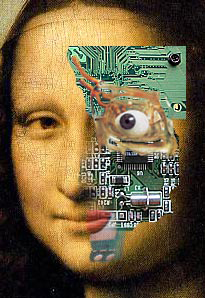HOW
THE CAMERA SEES
THE
SECRET
The secret of using the camera, is to keep the key elements of the subject as visually
close in your mind to the actual subject tones as possible, by learning
to "read" the light and shadow areas of the subject
from the position of the camera the way film will record it. NOT the way our human eye does with the brain
and emotions attached - the way you think it might be.
However
- to be creative, we need to approach the subject in a subjective
manner where you question why you are taking the photograph
and how you can best achieve this - but by contrast - learn
to read the images you have taken in an objective manner,
where you question what is actually in the print not what
you think is on the print associated to your memory.

From an exhibition - Watch Who - what - where do you watch
|
When
we substitute a single glass lens, the mechanics of
the camera and a chemical emulsion or CCD, for the human
eye there is a great difference. The camera can take
the photograph in a fraction of a second or perhaps
over several minutes. It is not capable of scanning
the scene or remaining selectively on one area of what
is in the frame the way the human eye does. The iris
does not respond to light changes during the exposure
or to the varying intensity of light on various parts
of the subject. Consider that if the film is black &
white, the sensitivity will not record colour and even
the black and white values will not be relative to the
brightness range as seen by the eye. |
Unless
we control the light onto the subject as we intend and use
the aperture and shutter controls to produce the desired effect,
the camera will record all information with impunity.
Nothing will be intensified nothing will be neglected. It
is the photographers responsibility to notice the smallest
details and control the scene as they require it for the photograph.
Because
of the single lens of the camera, dimension will be lacking
and, of course we can not hope to automatically capture the
beauty, mood or aesthetic qualities that may have been observed
in the original scene. These values and other desirable effects
must be "created" by the photographer through their knowledge
and skill.
With
experience, it is possible to acquire what is known as a "camera
eye" or " camera vision". This is when you have
the ability to interpret a scene in terms of how it will appear
on the film and adjust the situation before the exposure is
made.